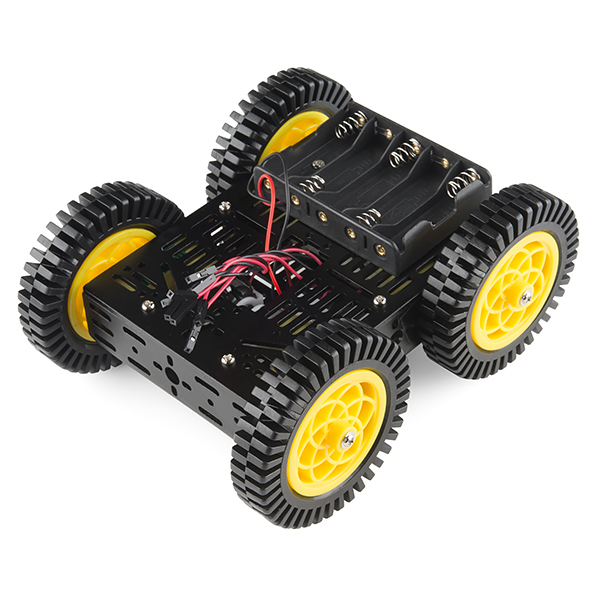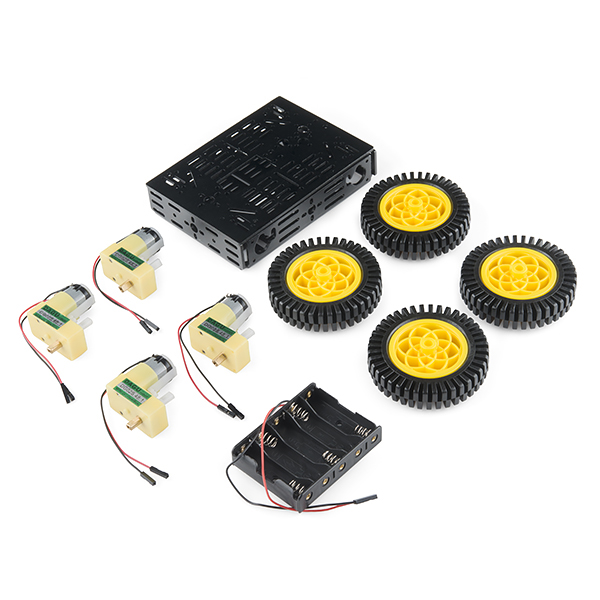Multi-Chassis - 4WD Kit (ATV)
This is the Multi-Chassis ATV 4WD Kit, an easy to assemble and use robot chassis platform. The Multi-Chassis kit provides you with everything you need to give your robot a rugged four wheel drive platform with plenty of room for expansion to add various sensors and controllers. All you need to do is supply is a basic motor driver and power and you'll be ready to drive!
This Multi-Chassis Basic 4WD Kit includes four 48:1 DC gearboxes that independently drive each of the 78mm high-profile wheels. The larger wheels give you clearance for driving through more difficult terrain like grass or sand. The gearboxes have a metal output shaft for more durability. Each side of the 2.5mm thick aluminum frame comes cut with plenty of attachment points to add a multitude of different robot controllers, drivers, and sensors.
Note: A building instruction booklet with a complete list of items included is inside this kit and in the documents section below. This comes as a kit but includes all the hardware and tools necessary for assembly.
- 1x Aluminum Frame
- 4x 48:1 DC Gearbox
- 4x 78mm Diameter High-Profile Wheel
- 4x M3 25mm Standoff
- 6x M3 8mm Screw
- 4x M2.5 25mm Screw
- 4x 2.5 20mm Screw
- 8x M3 8mm Screw
- 8x M2.5 Nut
- 2x M3 Nut
- 1x 5 AA Battery Holder
- 1x Spanner
- 1x Screw Driver
- Completed Kit Size - 178L x 135W x 78H mm
- Wheel Diameter - 78 mm
- Datasheet (DG02S Gearbox)
- Instruction Booklet
- Product Video
Multi-Chassis - 4WD Kit (ATV) Product Help and Resources
Core Skill: Robotics
This skill concerns mechanical and robotics knowledge. You may need to know how mechanical parts interact, how motors work, or how to use motor drivers and controllers.
Skill Level: Rookie - You will be required to know some basics about motors, basic motor drivers and how simple robotic motion can be accomplished.
See all skill levels
Core Skill: DIY
Whether it's for assembling a kit, hacking an enclosure, or creating your own parts; the DIY skill is all about knowing how to use tools and the techniques associated with them.
Skill Level: Noob - Basic assembly is required. You may need to provide your own basic tools like a screwdriver, hammer or scissors. Power tools or custom parts are not required. Instructions will be included and easy to follow. Sewing may be required, but only with included patterns.
See all skill levels
Core Skill: Electrical Prototyping
If it requires power, you need to know how much, what all the pins do, and how to hook it up. You may need to reference datasheets, schematics, and know the ins and outs of electronics.
Skill Level: Rookie - You may be required to know a bit more about the component, such as orientation, or how to hook it up, in addition to power requirements. You will need to understand polarized components.
See all skill levels
Comments
Looking for answers to technical questions?
We welcome your comments and suggestions below. However, if you are looking for solutions to technical questions please see our Technical Assistance page.
Customer Reviews
3.8 out of 5
Based on 6 ratings:
3 of 3 found this helpful:
Great robot chassis
This robot chassis is great for building your next robot. Because it has 4 motors, this is not a chassis for the beginner. The aluminum frame provides a low center of gravity making the robot stable and not easy to turn over. There are plenty of attachment points so you have plenty of configuration options and devices. There are two areas that could make this chassis even better; a wider frame and option to configure the chassis with only two motors. A wider frame will provide additional area for sensors. Lastly, adding an option to configure/drive the chassis with only 2 motors will provide a beginner with a platform that can learn robotic now and can continue to expand as he/she gains knowledge.
2 of 2 found this helpful:
Solid Chassis Construction, but Weak Motors.
Even when running the motors at ~4.2v (across the terminals), which is above the recommended 3v (from the datasheet), the motors seem to have a very hard time pushing the heavy chassis around at anything more than a crawl and stalls out at the smallest of obstacles.
EDIT: Unless the datasheet is wrong and I should be running these closer to 6v or even 9v -- but I don't want to burn out the motor testing that out.
1 of 1 found this helpful:
Just good to go.
Chassis, motors, wheels and a battery box. Additional motordrive is necessary. Gear ratio is quite high, which means this kit is made for a tank rather than a car.
1 of 1 found this helpful:
it's ok
The chassis is quite heavy. Attempting to run this with a 9V battery fails, you will need the AAs as shown in the image. Even then, it stalls out at very low barriers. I found myself wishing I just had plastic sheets-- much lighter and I could drill mounting holes where I want them instead of trying to shoehorn components into predrilled holes.
Nice
Very nice and solid construction
0 of 1 found this helpful:
nice kit
I love it




Could someone recommend a good motor driver for this chassis? I think for some chassis such as Redbot this is self-explanatory but for someone like me who is looking for a bit more oomph and customizability than Redbot, but still is an amateur, it would be real helpful to have some suggestions on motor controllers for a more open-ended selection such as this.
Someone in the comments linked to this one: SparkFun Motor Driver - Dual TB6612FNG (1A)
This says it will drive 2 motors, but this chassis has 4. It's likely most people will configure this chassis to run each side of motors independently (left vs. right). Is it kosher to just hook up the motors to an output on the motor driver board in parallel? Two motors per output channel? Is that a no-no? Newbie needs help!
I know there are newer selections for chassis here at Sparkfun, but this one intrigues me as it could run outside over various terrain easily, has a decent amount of space for components, yet still is affordable.
Has anyone run one of these with the adafruit motor shield and Dagu encoders? I just put my ATV together and the wheels are definitely turning at different speeds. It's going to be a trick to get one of these to drive in a straight line.
Finally got the kit put together. Used an iMX233-OLinuXino-MICRO, wifi USB dongle, TB6612FNG, and bluetooth dongle. The Wifi is used for uploading and editing files. Bluetooth is used to connect to a wiiremote with a classic game pad.
Is there anyway to get some extra motors? Mine dove off my desk and is now having issue with two of the motors :( Id rather not have to buy a whole new kit for parts!
EDIT: For anyone with a similar problem I found where to get replacement motors.
http://www.dagurobot.com/goods.php?id=86
Those are not the correct motors. Those are 100% plastic.
Isn't this a bit too expensive for a plastic box, some wheels and 4 motors with reduction boxes? I don't really see anything that justifies the $45 price tag :/
got mine in today, the frame is pretty solid aluminum . I don't know about the motors yet. but yeah its somewhat a little high in cost, drop $5 or $10 then it could be a solid buy.
edit: just notice, the basic kit is $10 cheaper, it seems just the wheels are different.
I'm curious, could I use this platform with Macanum Wheels? Say: https://www.sparkfun.com/products/11578 ? I want to make a macanum robot over the summer.
What would be the best way to drive all these motors independently? Would the Rover 5 driver board be the easiest way, even without having encoders?
The spec sheet says the motors draw 170ma Max@3v putting them in the range of this controller (x2): Motor Driver 1A Dual TB6612FNG
I agree and I'm also going to rely on the spec sheet (it matches the DG02S that is printed on the sticker on the actual motors). However, a funny thing is that the box that this kit arrives in says on the back that the "Motors Specifications" are 6V-9V supply, 800 mA nominal current, and 2000 mA stall current!! Again, I think I'm going to trust the spec sheet and plan for 170 mA max @3V, but I thought I'd mention this. Maybe one of the sparkfun folks can ask the manufacturer what is up with the numbers printed on the box?
Thanks, I think this would work just fine.
I'm confused a bit, the gearbox datasheet (only one we have) seems to indicate that the motors run off of 3V. So why do we have a 6 battery pack, (1.5 x 6 = 9V). What voltage are the motors rated for? do we have a Datasheet for them? I'm curious to know stall current and stall torque,
mine came with a 5 battery pack.
Lego tread! That brings back some memories.
Just a silly question, how can this steer? reversing one of the motor?
PWM would be the best answer
The new product page mentions encoders, but the detail page has no information. Are there encoders? on all four wheels? What's the counts per revolution? Inquiring minds want to know!
There are no encoders on this model nor the basic kit, only the rescue platform have them. Sorry!
Are the gears plastic or metal? Is it possible to get specs for the included motors? Stall current, speed and torque? If they've got enough power this could be a great shortcut for a project I was about to start on using Pololu parts.
Only the final gear and the output shaft in the gear box are metal, the rest are plastic. We can definitely see about getting a specs/datasheet for the gear box up though.